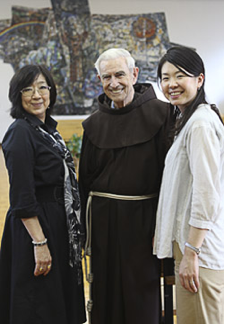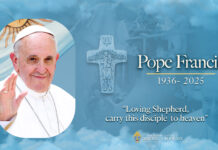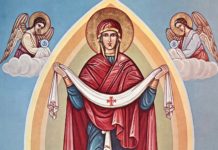This is part seven in a series of blogs from Dr. Asher’s trip to Japan.
Editor’s note: Dr. Jim Asher had the opportunity to speak with Franciscan Father Callistus Sweeney during his trip to Japan. He asked Fr. Sweeney about the history of Catholicism in Japan and why Christians make up less than 1 percent of the population.
The Franciscans

Fr. Callistus Sweeney, OFM is thin and ascetic looking. His easy laughter is surprising if you didn’t realize Christian asceticism includes good humor. We talked after the 8 a.m. English Mass at the Franciscan Chapel Center in Tokyo.
Franciscans have figured strongly in Japan, and have included Fr. Maximilian Kolbe, OFM, whose Marian magazine has been published since the 1930’s from the monastery he established in Nagasaki.
Fr. Sweeney has been in Japan since 1955 and is still active at 84. He relates that shortly after his arrival there was great poverty, and amidst their hard times, many people were looking for answers they did not find in their typically combined practice of Buddhist-Shinto religions. In those days, it was not uncommon for someone to drop in to talk, and he estimated there were then about 20,000 conversions a year.
The contribution of Catholic education
Catholic schools are much sought after according to Father, and I have found it so throughout Asia. They remain an occasional source of conversions, and an important way Catholicism gains acceptance in traditional culture. However there are fewer religious to staff the schools, and even finding lay Catholic faculty is problematic. Besides which, they are too expensive for many Catholics.
Abortion is an unhappy choice
Abortion, Father verified, is illegal in Japan. Unfortunately, as it did in the U.S. just before the Roe v. Wade decision, almost any excuse will allow an exception, so it remains easily available. He believed that most Japanese women have deep regret about having one, as he pointed out that in some Shinto temples, there are special devotions for mothers of babies that were stillborn or died through miscarriage or abortion. This is also true in Japanese Buddhist practice. However, abortion in Japan has been practiced since the 12th century and where not available, couples frequently resorted to infanticide in the past.
Government and media
Father believed that unlike in the U.S. today, both the government and media are fair to the Church, and respectful of its moral teachings. Indeed, there was a Catholic Prime Minister in 2008. Outright persecution of Catholics stopped in 1873, but beginning in the 1930s and through the end of World War II, militarism dominated Japanese politics. Because it was looked upon as foreign, there was government sponsored harassment of the Church. Father relates it included some churches being burned, and mistreatment of Catholics. Perhaps 68 years is not yet long enough for people to realize good Catholics can be good Japanese.
Translating ‘God’ into Japanese
The bishops of Japan were fearful that the Shinto derived word for “God” could be considered singular or plural – there are innumerable gods in Shintoism. Protestants went ahead and used the word. Father thought they had been more successful with current evangelization. There are about as many Protestants in Japan as Catholics, together accounting for about one million people, or 0.8 percent of the population.
Our Lady of Akita?
We discussed the unusual events surrounding a nun and a statue of our Blessed Mother in Akita Japan. Sister Agnes Katsuko Sasagawa, of the Institute of the Handmaids of the Eucharist, was cured of her deafness, and the three-foot wooden statue shed human blood and tears on many occasions. These facts are incontrovertible. Whether they — plus the claimed visitations of angels, and Our Lady — were of Divine origin is somewhat open to question. Bishop John Ito of Niigata, in which Akita is located, witnessed the statue issuing forth verified human tears on four occasions. There were more than 100 such manifestations, and some 500 eyewitnesses to them. The bishop expressed belief in the miraculous authenticity, although upon his retirement his statement was somewhat equivocal. Then-Cardinal Ratzinger was involved, and more recently it has been featured on EWTN. Bishop Ito’s successor upon retirement was Bishop Sato, OFM, now deceased. He and Fr. Sweeney were good friends and this bishop was apparently a bit more skeptical yet did not discourage the devotion. It seems with the present Bishop Tarcisio Kikuchi, SVD, veneration of the statue is neither encouraged nor discouraged, while at the same time any veneration of Our Lady is commended as a faithful practice.
I wondered if this apparition had any special significance for Japanese people, as Our Lady of Guadalupe had for Native Americans, but Father didn’t know. He knew of no healings or other special manifestations from the time of these events which occurred in 1973-79. He did note however, there have been many pilgrimages, especially from the Philippines. Akita is purported to continue the message of Lourdes and Fatima and, like them, is out of the way. Even on one of the fastest trains it’s a four hour ride from Tokyo.
And now
In the midst of poverty, conversions were 20,000 a year. Prosperity has brought about a corresponding decrease. Although he doesn’t think this is the only reason, Fr. Sweeney, like others I have asked, doesn’t know why there isn’t more interest in the Church today. He noted that with fewer conversions, there are also fewer vocations to consecrated life. He waits, far from his roots in upstate New York. His is a gentle presence to anyone who would want to talk to him. And like the others, he prays for the souls for which he has given his life.






